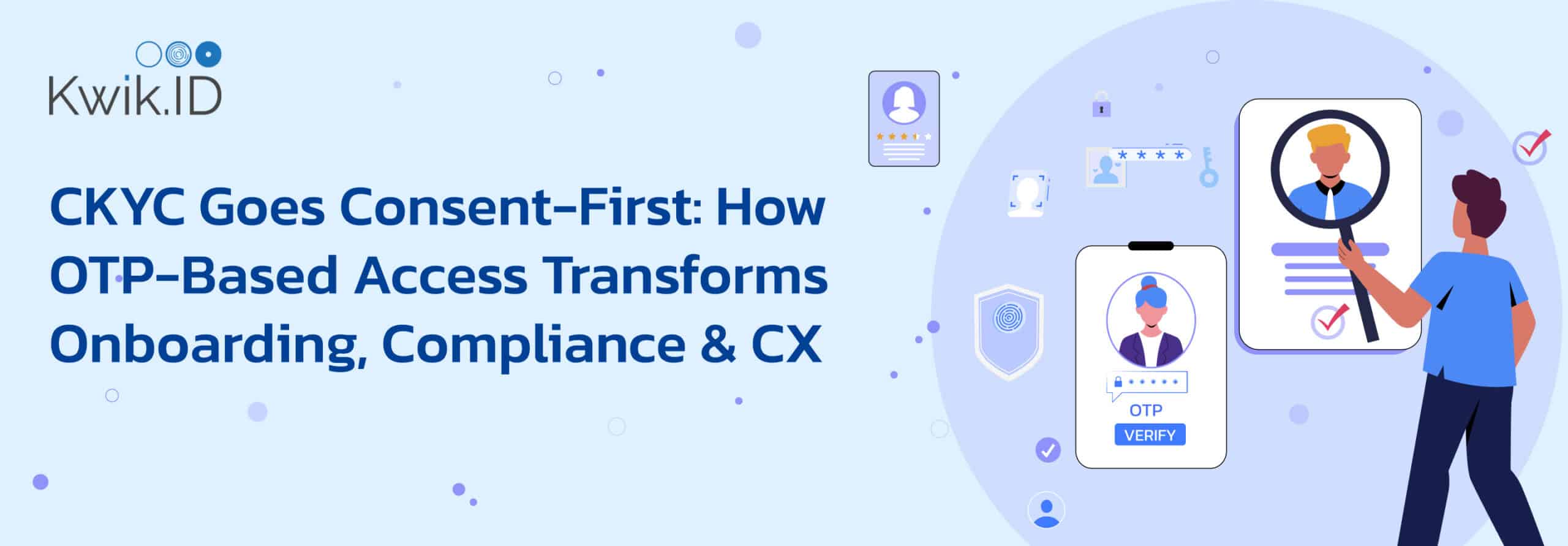How the new OTP-based CKYC download impacts onboarding, compliance, and customer experience across financial institutions
Introduction
In April 2025, the Central KYC Records Registry (CKYCRR) introduced a crucial upgrade to the CKYC framework: mandatory OTP-based consent for downloading individual KYC records. Under this mechanism, every time a financial institution (Reporting Entity, or RE) attempts to retrieve a customer’s CKYC data, an OTP is sent to the customer’s registered mobile number. The record is released only upon successful OTP validation. Issued under Circular No. CKYC/2025/02, this move enhances transparency and user consent in KYC operations across the BFSI landscape.
Why This Update Matters
CKYC serves as India’s centralized repository of customer KYC records, managed by CERSAI. It allows banks, NBFCs, insurers, and other REs to reuse verified customer identity data using a unique CKYC Identifier (CKYCR ID), thus simplifying onboarding and avoiding duplication.
Previously, CKYC records could be fetched by an RE without any real-time customer involvement, based solely on identifiers like PAN or Aadhaar. The OTP-based consent mechanism addresses this gap by requiring customer authorization at the moment of data access, thereby aligning CKYC usage with India’s data protection norms that mandate informed consent for personal data sharing.
This shift not only adds a security layer but also instills greater customer confidence in how their data is handled.
How the OTP-Based Download Works
Going forward, any attempt to download an individual’s CKYC record (via portal or API) will follow this flow:
- Trigger: CKYCRR sends an OTP to the mobile number registered with the KYC record.
- Validation: The RE submits this OTP through the system/API.
- Access: Only upon validation is the KYC data shared. OTP expiry or failure halts the download.
This modifies the CKYC retrieval process from a single-step fetch to a consent-driven two-step authorization.
| Process Step | Previous (Old Process) | New (OTP-Based Process) |
|---|---|---|
| 1. Search for KYC Record | RE searches the CKYC database for the customer’s record (using PAN, etc.). If a record exists, it can be located along with the CKYC ID. No customer involvement required at this stage. | RE searches the CKYC database for the customer’s record (same as before). If a record exists, it is identified. No change – searching the registry is unaffected by the OTP update. |
| 2. Initiate KYC Download | If a record is found, the RE initiates a download (via the CKYC portal or API). The CKYCRR immediately returns the customer’s KYC details to the RE’s system. No additional authentication was needed for data retrieval. | If a record is found, the RE initiates a download request. Now, CKYCRR sends an OTP to the customer’s registered mobile number as soon as the request is made. The RE (or their application) must prompt the customer for this OTP. |
| 3. Authorize & Retrieve Data | (Not applicable previously – the data was provided instantly after step 2.) The RE could view/use the KYC info right away. | The customer provides the OTP (e.g., tells the bank officer, or enters it in the app/website). The RE submits this OTP to CKYCRR for verification. Only upon successful OTP validation does CKYCRR release the KYC data to the RE. If OTP validation fails, no data is shared. |
Only individual CKYC records are impacted by this update. Non-individual entities continue with existing procedures.
Technical & Operational Changes
Search Workflow remains unchanged. However, download initiation now presents a “Send OTP & Download” prompt. No data is displayed until OTP validation succeeds.
API v1.3 Update:
- Search and Download APIs require SHA-256 hashing.
- Download is now a two-call process: initiate + OTP validate.
- API v1.2 will be deprecated post May 31, 2025 (8 PM).
- New APIs go live on May 9, 2025.
Institutions must update front-end interfaces for OTP entry and back-end systems for new API workflows.
CKYC Upload Flow: Unchanged but Affected
Uploading new or updated KYC data remains the same. No OTP is required for uploads. However:
- Duplicate Records Risk: OTP failure due to outdated phone numbers may force REs to collect and upload a new KYC, possibly creating duplicates.
- Efficiency via Reuse: Successful OTP validation lets REs reuse existing CKYC data, skipping document collection if details are current.
This incentivizes institutions to help customers update their contact information proactively, improving CKYC record accuracy.
Industry-Wide Implications
Banks must retrain staff and revise onboarding workflows across both physical branches and digital platforms to accommodate the new OTP step, which, though minor, significantly enhances data security and consent tracking. NBFCs must integrate OTP into their field and digital onboarding journeys, particularly benefiting from smoother CKYC reuse for repeat borrowers—provided timely technology upgrades are implemented. Fintechs gain from a low-friction, Aadhaar-independent KYC method, and sustaining a seamless user experience will depend on features like auto-OTP reads and intelligent fallback options. Insurance and securities players working through KYC vendors must ensure the OTP layer is smoothly integrated, offering enhanced regulatory assurance with minimal impact on user experience. Overall, the update reinforces trust, reduces redundancy, and ensures that KYC reuse is both secure and consent-driven across the financial services ecosystem.
Enhancing VKYC and Digital KYC Journeys
The OTP layer fits naturally within video and digital KYC processes:
- Video KYC: OTP can be triggered pre-call or during the session to fetch verified data, reducing manual entry and aiding officer verification.
- Digital KYC: Apps can offer CKYC + OTP as a document-free onboarding option. Live selfie checks can complement CKYC-sourced details.
- Consent Logs: OTP attempts are system-logged, adding audit-grade proof of customer authorization.
This hybrid approach boosts both security and speed in remote onboarding models.
Benefits of the OTP Mechanism
- Explicit Consent: Customers approve every data retrieval in real time.
- Enhanced Security: OTP adds a second factor to protect sensitive data.
- Improved Data Hygiene: OTP failures surface outdated mobile numbers, prompting updates.
- Operational Gains: Valid CKYC reuse can cut onboarding time and paperwork.
- Audit Trail: Every access is logged, aiding compliance and regulatory reporting.
Infrastructure Alignment: Syncs CKYC with consent-based ecosystems like Aadhaar and Account Aggregator
Implementation Challenges
The implementation of the OTP-based CKYC mechanism comes with several practical challenges that institutions must navigate. With only a few weeks before the v1.2 APIs are sunset, organizations are racing against a tight transition timeline to upgrade their systems and ensure compliance. Clear and effective customer communication is critical—users must understand why the OTP step is necessary to avoid confusion or drop-offs during onboarding. OTP failures, whether due to delivery issues or outdated mobile numbers, can disrupt the process and must be mitigated with fallback options. Full system readiness is essential, requiring synchronization across the entire tech stack, from front-end interfaces to backend APIs. Since the process relies on access to the customer’s registered mobile number, institutions must have alternate procedures for those without access. Finally, uniform adoption across the financial ecosystem is key to ensuring a consistent and seamless customer experience, highlighting the need for coordinated efforts across banks, NBFCs, fintechs, and service providers.
Conclusion
The CKYC OTP-based download is a transformative step in India’s KYC evolution. It shifts the focus from efficiency-only to efficiency with consent, reinforcing customer trust and aligning with modern data governance standards. For the BFSI sector, it brings short-term integration effort but delivers long-term benefits in data fidelity, security, and regulatory robustness. Customers, on the other hand, gain greater visibility and control over how their personal information is accessed and reused.
At Think360.ai, we are fully aligned with this shift — updating APIs, refining digital onboarding flows, and helping our partners stay ahead of compliance deadlines. Powering this readiness is Kwik.ID, the most intelligent, scalable, seamless, and secure digital customer onboarding and KYC automation suite designed specifically for Indian BFSI enterprises. Kwik.ID ensures that financial institutions can confidently navigate regulatory changes like the CKYC OTP mandate, while continuing to deliver smooth, high-trust onboarding experiences at scale.
This OTP-based mechanism is not just a compliance safeguard — it’s a bold statement that trust, transparency, and customer empowerment are at the core of India’s digital financial future.
For CKYC implementation, upgrades and integrations, please write to us at sales@think360.ai or dial/WhatsApp us at +91 8779798844.










